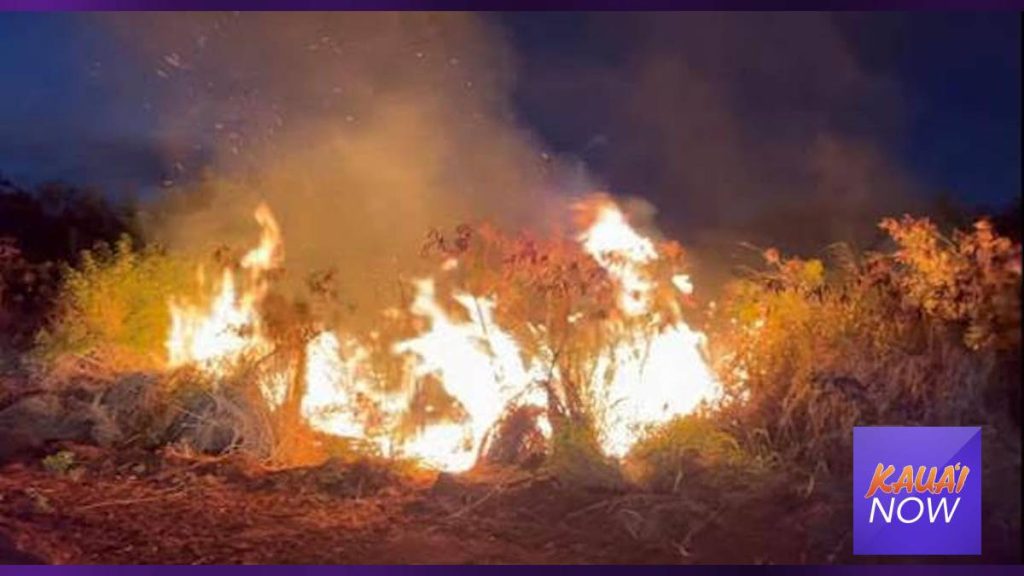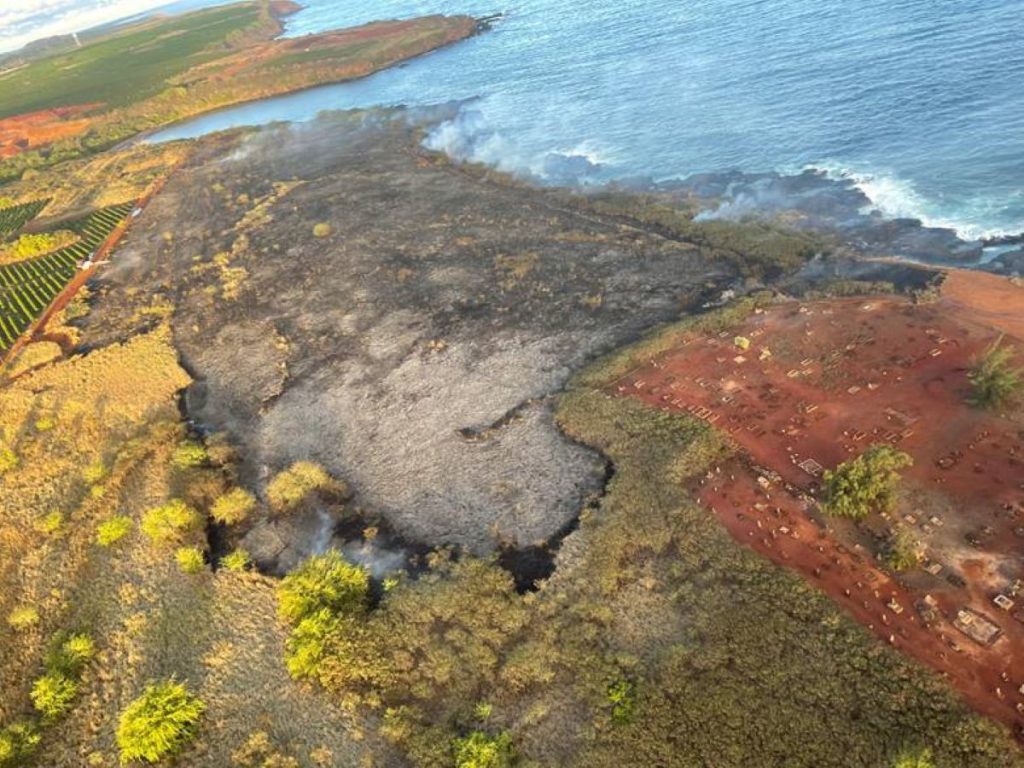Red Flag Warning Over, But Dry Conditions Likely to Persist

Leeward portions of the state, including on Kaua‘i, remained under a red flag warning through most of Monday, Aug. 1, as fire weather conditions persisted. According to a hydrologist with the National Weather Service in Honolulu, the islands will probably continue to see drier weather through the rest of summer and into fall.
Kevin Kodama, a senior hydrologist with the NWS, said Monday that a trend of drier weather is likely to continue.
A lack of rain, warmer temperatures and an increase in trade wind strength fueled dry conditions and low humidity this past weekend, which resulted in the red flag warning. A wind advisory was also in effect.

Both advisories either ended or were canceled by Monday afternoon.
Leeward areas of the state, especially the lower slopes, are at most risk of fire weather, according to Kodama. The Humu‘ula Saddle region of the Big Island is also prone to extreme fire conditions.
“Tropical cyclones, or their remnants, could provide some relief, but it is not possible to know for sure if/when these may come through,” Kodama said.
Below normal precipitation is favored for the Hawaiian Islands in August, according to the NWS Climate Prediction Center. Drought also looks to persist in several parts of the state.
That could mean an increased risk of wildfires.
“Wildfires occur on every island, on both windward and leeward sides, especially during drought episodes like the one projected for the next few months,” Andrea “Nani” Barretto, co-executive director of the Hawaiʻi Wildfire Management Organization, told Kaua‘i Now on Monday in an email.
Historically, wildfire season runs from late spring through early fall, according to the Kaua‘i Fire Department. The southern and leeward portions of the island are most prone to wildfires, including area such as Poʻipū, Hanapēpē, Waimea and Kekaha. Waimea Canyon and Kōkeʻe State Park also see blazes, and there have been large brush fires on the eastside of the island, from Līhuʻe to Anahola.
In the past three months, the department has responded to 78 wildfires, including 22 in May, 23 in June and 34 in July.
Some of the largest wildfires have occurred in the Waimea Canyon and Kōkeʻe State Park areas. In recent history, the largest wildfire causing the most significant financial loss on Kaua‘i happened 5-6 years ago in the Poʻipū area, according to the fire department.
“The wildfire damaged several homes along Kipuka Street; one home was consumed and deemed a total loss,” the department told Kaua’i Now on Monday in an email. “The barren and dry fields past the Hyatt Regency Kaua‘i, near CJM stables, have been a trouble spot in recent years.”
Three of the largest fires on the island, in 2012, on state lands were a fire in Kekaha that consumed more than 2,000 acres, the Hikimoe Ridge Fire that consumed more than 800 acres and the Miloliʻi Fire, which consumed a little less than 300 acres. When wildfires happen on state land, the Kaua‘i Fire Department provides mutual aid assistance, including personnel and equipment, to contain, control and help extinguish the blazes.
Wildfires are dangerous to the people living or visiting the places where they occur, but there also are numerous hazards for the firefighters who battle them beyond the fire itself and the smoke it produces. A Kaua‘i firefighter was recently injured while fighting a brush fire in Kealia.
“Weather, humidity, time of day, wind speed, terrain, location, roads, access, etc., greatly influence conditions on the fire ground,” the fire department said. “Company officers are trained to conduct a proper size-up, develop an action plan and implement strategies and tactics to successfully control, contain and extinguish the fire with life safety as a priority.”
That includes calling for additional resources, aerial support, etc., and all firefighters receive more than 40 hours of wildland firefighter training from state Department of Land and Natural Resources Division of Forestry and Wildlife personnel on Kaua‘i.
“This training includes being aware of changing fire ground conditions, identifying a safe zone if the fire changes direction and, more importantly, calling for additional resources early,” the department said.
Thick, dry brush burns fast and hot and high winds quickly spread fires across large areas.
“The fires out in the Anahola area pose significant threat to our personnel,” the fire department said. “Dumping of household goods, appliances and vehicles in the area blocks firefighting access and poses a substantial danger to our personnel.”
The department said to combat those hazards, firefighters having the correct training and equipment is essential. That preparation continues on the scene of a fire, with first responders prioritizing proper assessment, an action plan and tactics and life safety.
“The department has also taken a proactive approach, working with private and public land owners to improve and/or secure access to their properties, create fire breaks, maintain access roads, etc.,” the fire department said.
Barretto said firefighting is the last line of defense against wildfires — everyone doing their part ahead of time is the best way to prevent these types of fires.
“The important thing to remember about wildfires is that they are different than other natural hazard events in that they can be prevented and their impacts reduced if we are proactive,” she said.
There is a lot people can do, individually and collectively, to protect homes, families and communities from wildfire.
“Did you know 99% of fires are caused by people, many of them by accident, so don’t be the cause,” Barretto said, adding now is the time to take action and be wildfire-aware.
She offered these wildfire prevention tips:
- Don’t pull over on dry grass, wait for a paved or gravel pullout. Don’t use equipment that sparks in dry areas or on windy days.
- Make and practice a family emergency plan. Include neighbors who might need help.
- Since fires can only travel where there is fuel, keep grass short and trees trimmed high. Clean leaf piles around your home, yard and rain gutters. Anywhere wind blows leaves, it can blow embers.
- Finally, get involved in your community’s efforts to reduce fire hazards in and around your neighborhoods. Click here to learn more about the Hawai’i Firewise Communities Program to get started.
The Kaua‘i Fire Department said fire prevention includes not playing with matches or lighters; misusing fireworks, especially illegal aerials; and discarding cigarettes. The department urged the public to be mindful and have a hose at the ready if they have a permit to burn green waste or are making a cooking fire.
People can also create a firebreak around their property. A resident impacted by the Poʻipū fire on Kipuka Road had planted a garden in her backyard and cleared brush behind her house, the fire department said, adding the action saved the woman’s property. The fire caused only minor damage to a small section of the roof on a shed.
For more information and tips to prepare for and prevent wildfires, Barretto and Moller encourage people to visit the Hawaiʻi Wildfire Management Organization website.
“We want our islands to be wildfire-ready and wildfire-safe, and it’s going to take all of us (to) get there,” Barretto said.



